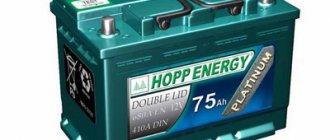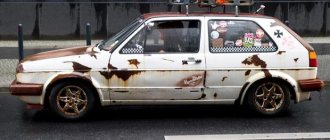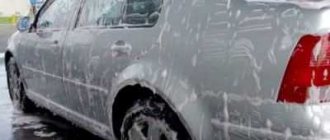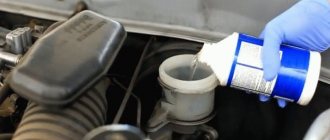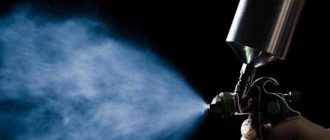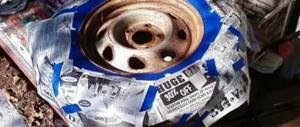Car tuning often costs a lot, and does not always satisfy the customer’s initial requirements. That is why many who have decided to do this on their own are interested in how much paint is needed to paint a car. As practice shows, painting a vehicle is possible if you have some experience in working with dyes. This can be easily learned, but our article will help you study the requirements for painting a car. We will look at how to correctly calculate a sufficient amount of paint, what material is best to choose and what factors you should pay attention to when purchasing.
What affects paint consumption?
Specialized stores offer a wide selection of different paints for painting cars. However, it is worth noting that the cost of this type of product is very high. Nobody wants to overpay for one-time painting and buy extra. Before buying a coloring composition, it is necessary to make a preliminary calculation. After all, if there is not enough paint, you will have to urgently buy more, and it is not always possible to choose an identical shade.
When calculating the amount of material, consider the following:
- parameters and model of the vehicle, as well as its condition;
- preferred type of paint and its packaging;
- availability of certain necessary tools;
- weather and working conditions.
These are just the main parameters that affect the amount of substance consumed. Also, paint consumption is affected by the thickness of the coating, the number of layers applied and the method of painting. Thus, it is very difficult to calculate the exact amount of material; you can only rely on standard figures.
What are the advantages of this painting method?
Compared to painting using other methods using a roller or brush, painting a car yourself with a spray can has a number of advantages.
These include:
- ease of application;
- simplicity of the process;
- When painted correctly, the layers lie smoothly and neatly.
You can paint a car yourself in the garage
If you paint a car with a spray can yourself, then the owner needs to remember the negative aspects of this method of painting a car:
- paint purchased on the market may not be original or a cheap fake. This will affect the color, which will be different from what is on the body. To avoid the issue of color differences, you need to choose a suitable shade and buy only from official manufacturers. Before applying, make sure the color is suitable. To make sure of this, you need to paint any other piece of metal and let it dry. Then compare both colors;
- If the car owner takes up a spray can for the first time, he may not be able to apply an even layer of paint. You need to practice on individual pieces of metal and find information on how to spray paint without smudges.
If the car owner is confident in his abilities, then he can move on to painting the car.
Average consumption rates
So how much paint does it take to paint an average sized car? Experts note that painting damaged areas of a car fender or door is a widely applicable service. This process requires about 150 ml of dye, but to paint a bumper (medium size) you need at least 300 ml.
To paint a larger bumper, the hood or the trim of the entire vehicle, you need from 600 to 1000 ml, respectively. It turns out that approximately 250 ml of paint is needed per square meter of coating.
Below is a table with car enamels consumption indicators:
| Part or area/vehicle type | Consumption in ml/l |
| Hood | 400-600 |
| Wing | 150 |
| Bumper | Up to 300 |
| Door | Up to 200 |
| Upper part (roof) | Maximum 400 |
| Trunk (lid) | 300-400 |
| For painting a medium sized car | 2-3 l |
| For painting Gazelle | Up to 5 l |
What to consider when calculating?
Even a professional finds it difficult to answer the question: how many liters of paint are needed to paint a car? The fact is that it depends on many factors:
- make of the car and its condition;
- type, color and packaging of paint;
- necessary tools, including a spray gun;
- weather conditions, etc.
Let's briefly look at each of them.
Body
When calculating paint consumption, the area of the surface to be painted is first taken into account. It is clear that as the size of the part or the dimensions of the car increases, the volume of paint required will increase.
Also, its consumption will depend on the condition of the machine and, in particular, on the color and texture of the substrate or primer. If the car body has a good primer and sanding produces a finely porous texture, the paint will be used sparingly, since sanding stimulates high adhesion.
Paint and varnishes
The brand of paints and paint materials of different brands in general are unique in composition and therefore have different covering abilities. Color also plays a role. White and bright green paints have the best covering properties, while light red, blue and yellow compositions have worse covering properties and they have to be applied in 2-3 layers.
Consumption can be reduced when a gray-black base is covered with a light coloring composition or a white base with a dark paint. But the situation with light yellow, blue and red on dark soil is different - more paint may be required.
The picture is slightly different with the consumption of varnishes, which is influenced, in addition to covering ability, by their base. It is smaller than synthetic resin ulak, and acrylic and nitro-combined analogues “cover” worse.
Their consumption is also influenced by the so-called. “filling capacity”, the properties of a coating on an insufficiently sanded base or not processed at all, to form a high-quality gloss.
Tool used
To more accurately determine how much paint is needed to paint a car, you need to take into account the type of spray gun used as a painting tool. After all, some amount of paint remains in the tool and is consumed in the process of spraying onto the car body, which is taken into account by the so-called. transfer coefficient of the spray gun.
Other factors
The consumption of material depends on the technology of painting the car, as well as on the thickness of the layers and their number. The optimal consumption will be when the old finely porous base is well sanded and covered with paint of the same color.
The consumption of varnish and paint depends on the temperature, since too cold paint materials form flowing “tears”. Another important characteristic of paintwork materials is related to temperature – viscosity.
If you paint with thick paint, the result is an unsightly “orange peel” on the car, and with thin paint, poor adhesion and “tears” will form. This requires careful handling of the solvent. Mix it with paint strictly according to the instructions on the paint packaging. When mixing paintwork components, you may need a real viscometer or at least a graduated container.
If you need to paint not only the exterior, but also the interior of the car, the total paint consumption increases by an average of 1 liter. It will almost double in size when painting a new part, because it must be painted on both sides.
Along with the factors described above and the subtleties of technology, the amount of material consumption and the quality of the coating are greatly influenced by the qualifications of the painter.
Choosing the best paint for a car
The paint consumption on a car directly depends on its type. To understand the basic properties of paintwork materials for tuning work and choose the best option, you need to study their composition. However, any high-quality paint consists of the following components:
- pigment that is responsible for color;
- connecting element (designed to attach the pigment to the required part of the body);
- solvent (responsible for the fluidity of paint).
So what kind of paint is suitable for painting a car? The following types of paints are most suitable for garage work:
- nitro enamels;
- alkyd;
- acrylic.
On the video: the main types of car enamels.
The best option is acrylic enamels. They have a number of undeniable advantages compared to other paint and varnish coatings:
- ideal combination of high quality and low price;
- uniform surface coloring;
- natural shine;
- long service life.
The advantages of acrylic enamels also include economical consumption. How much paint is needed per square meter? You only need 200 ml; bumpers and other large areas require up to two liters. And when painting the inside of a car, you will need no more than one and a half liters of paint.
Acrylic enamel is highly resistant to mechanical stress, so the coating does not need to be renewed every two to three years. This also saves you money.
Painting the outside of a vehicle using acrylic enamels is quite easy and quick, and does not require special skills or professional knowledge. This process takes about several hours.
Despite the fact that acrylic paint has high durability and pigmentation, the resulting coating cannot be polished. For the initial finishing of a car, you can use this type of paintwork, but for repainting, “soft” paints that are easy to polish (alkyd, nitro enamels) are more suitable.
On video: review of acrylic paint.
How much paint is needed to paint a car quantity and consumption liters
The paintwork of a car suffers the most during its operation: reagents, temperature changes and accidents can reduce the paint layer to nothing and lead to the need for immediate painting. If the owner decides to do the work himself, then he will have to take into account a number of factors, for example, consumption and the amount of paint that will be needed. In this article we will talk about how much material is needed to paint a car, and how you can reduce this figure by approaching this issue competently and responsibly.
Significant Factors
When a car owner wonders how much paint is needed to work on his car, he has to rack his brains a lot to get that coveted figure that will indicate how many liters will have to be purchased.
Usually, the car owner does not try to delve into the essence of the issue in any depth and looks at the numbers that are indicated on the packaging. Let us note right away: the data provided by the manufacturer should be treated with skepticism.
Firstly, the consumption rate is greatly influenced by what the final layer thickness will be. Usually the manufacturer indicates a minimum figure, which is fully consistent with the logic of modern marketing. In addition, the amount of material required for painting is influenced by the method of application and how well the working surface was prepared.
Secondly, no matter how hard they try to refute this fact, we must not forget that due to strong competition, a manufacturer may deliberately underestimate consumption in order to attract customers. In any case, it never hurts to take a small supply of material for painting a car, and if there is too much material left, it can be returned to the store.
Just the facts
Of course, car paint from different manufacturers has very different consumption, which can vary within a fairly wide range. However, you need to understand that there are average statistical indicators that help you roughly estimate how many liters are needed to paint a particular element.
The data below is needed for working with a well-prepared surface and a spray gun, which painters use in the vast majority of cases. So, to paint the hood you will need about 400 ml of material. You will have to spend a little less on painting the car wing: 250 ml of material. The radiator grille and threshold, by the way, will require less: 100–150 ml. In total - no more than 250 ml per square meter of surface.
Since these numbers are averages, we need to explore in more detail how material consumption can be reduced in order to ultimately save a significant amount of money. The first point to consider is the consistency of the substance itself. It is believed that the thicker the composition for a car, the more economical its consumption will be. In addition, an excessively liquid consistency will lead to the appearance of drips and drops, which cannot but affect the appearance of the car.
It is worth noting that a composition that is too thick will not be distributed normally over the entire area of the metal, so it is a good idea to determine the golden mean for yourself and dilute the substance to the required state.
Among other things, it is worth paying attention to the spray gun settings, which for the most part determine the consumption and thickness of the final layer of paint on the metal of the car. Without the proper skills, making proper adjustments is quite problematic, but training on old or unnecessary metal parts of machines will not be superfluous
Having experimentally achieved the required layer thickness, you can further save material and spend it more rationally.
Summary
Painting a car is a responsible task that is best undertaken only with high-quality equipment and proper experience. However, purchasing quality materials and paint for your car also contributes to excellent results. A competent approach to the matter will help you save material and money and subsequently learn how to do the job competently and no worse than a professional painter.
How much spray paint will you need?
The most inexpensive option is car paint in a can. On average, it costs between 150-350 rubles. However, few people think about how long such a can of paint lasts, because it is almost impossible to control the consumption of the substance in such a package. Note that one cylinder containing 150 g of paint is often enough to paint 0.25-0.5 m² of surface. To cover 1 m² of body area you will need at least 2-3 cans.
Only experienced mechanics can accurately answer how much of this paint is needed to paint a bumper, but at least 250 ml of the composition will be required.
However, little depends on the material itself; it is impossible to definitely calculate the amount of such paint. Depending on the manufacturer, the can may contain different volumes, and the quality of the enamel (for example, ductility and density) may be different.
Expert opinion (2 videos)
Various car enamels (24 photos)
Painting process
Painting your car with a spray can begins with shaking. Shake the can thoroughly with your hands so that the paint is completely distributed throughout the container. To avoid getting a surprise, try the can on a sheet of metal - this is called rehearsal painting. If the paint from a high-quality can also has instructions, then that’s great – study it carefully. If you have aerosol car paint, then painting occurs at a distance of 30 cm from the body.
It is important to maintain a temperature of 20 degrees. You are unlikely to be able to catch this temperature outside. The humidity should not be too high either.
Let's say you have completely covered the surface to be treated with your own hands - this is the base layer. Afterwards you need to apply two or three more layers, depending on the thickness of the paint. After each coat, take a 15-minute break while painting is in progress. The drying time for the final layer is 20-25 minutes. At the end of the work, you need to cover the painted part of the car body with a special varnish. Use exactly the same technology as with paint. Only here there is one feature - wash it off for 15 seconds after applying the varnish, then the painting will be of high quality.
We have also collected the most common problems that can be caused by cheap car paints in cans or non-compliance with technology:
- For example, if paint, even from a high-quality can, is applied to a body surface that has been poorly cleaned or over-primed, then after a few days the paint layer will come off. There is only one solution to the problem - we start painting again, only now more carefully and efficiently.
- If the paint supplied from the can has a high level of viscosity or the sprayer supplies it under too much pressure, then the body will not be painted evenly. Most often this happens when the driver buys paint that, in fact, is not intended for the car. Fortunately, this is easy to fix - just apply a new coat, which will solve the problem.
- If you notice that the treated surface of the car is rapidly fading, then most likely the putty material was selected incorrectly. To eliminate such a defect, clean off all the layers to gain access to the metal and reapply the putty.


